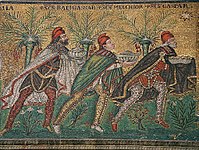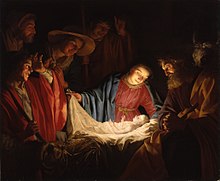Balthazar (magus)
Balthazar, also called Balthasar, Balthassar, and Bithisarea,
Tradition
The Gospel of Matthew does not give the names of the Magi (or even how many there were), but their traditional names are ascribed to a Greek manuscript from 500 AD translated into Latin and commonly accepted as the source of the names.[4] In this original manuscript, Balthazar is called Bithisarea, which later developed into Balthazar in Western Christianity.[2]
In early artistic depictions, Balthazar was represented as a white man.
As part of the Magi, Balthazar followed the
Balthasar and Gaspar, another of the Magi, are characters in the 1880 novel Ben-Hur: A Tale of the Christ and the various film adaptions of the novel, which chronicles his later years.
-
The Three Magi, Byzantine mosaic, c. 565 AD, Basilica of Sant'Apollinare Nuovo, Ravenna, Italy. Balthazar is depicted on the left
Commemoration
Balthazar, along with the other Magi, are purported to be buried in the
Blackface controversy and traditional iconic representation
Many traditionally Christian countries stage
Since King Balthazar, in traditional pictorial representations from the Late Middle Ages, is often represented as a black person (as an integrating or cosmopolitan graphic symbol, in the tradition that the "wise men" or "magi" who worshipped Jesus in Bethlehem represented the peoples of the whole world), fitting in with this traditional icon motivated his representation in the cavalcades of Three Wise Men by a person made up in black. In many Spanish towns that custom continues, while others now ask a prominent
-
A black man parading as Balthazar in Zaragoza in 2009.
-
The three magi in Massalfassar in 2019. Balthazar and his servant are played by white people in blackface.
-
Adorazione dei Magi (Adoration of the Magi) by Bartolomé Esteban Murillo, c. 1655 (Toledo Museum of Art, Ohio)
See also
References
- ^ "The Adoration of the Three Kings". The Walters Art Museum.
- ^ a b "Excerpta Latina Barbari: 51B". Retrieved 2016-01-01.
- ^ "Balthasar". Encyclopedia Britannica. Retrieved 2023-01-20.
- ISBN 9004061630
- ^ a b c "Exhibition Explores Balthazar, an African King, in Medieval and Renaissance Art". Getty Museum. 2010-09-05. Retrieved 2024-01-01.
- ^ "The Blackening of Balthazar". Comment Magazine. 2023.
- ^ "Exhibition Explores Balthazar, an African King, in Medieval and Renaissance Art". Getty Museum. 2010-09-05. Retrieved 2023-01-01.
- ^ Matthew 2:11
- ISBN 978-0313330841.
- ISBN 9780870991806.
- ^ David Lowenthal, The Heritage Crusade and the Spoils of History (Cambridge: Cambridge University Press, 1998), xvi.
- ^ "Magi". Catholic Encyclopedia. 1910-10-01. Retrieved 2016-01-01.
- ^ "¡¡Guerra al Baltasar pintado!!" (in Spanish). GuinGuinBali.com. 2012-02-13. Archived from the original on 2016-01-08. Retrieved 2016-01-01.
- ^ "El rey Baltasar de Pamplona seguirá siendo un blanco pintado de negro" (in Spanish). elperiodico.com. 2015-12-30. Retrieved 2018-12-15.





